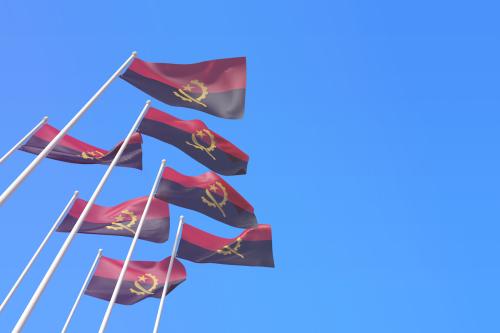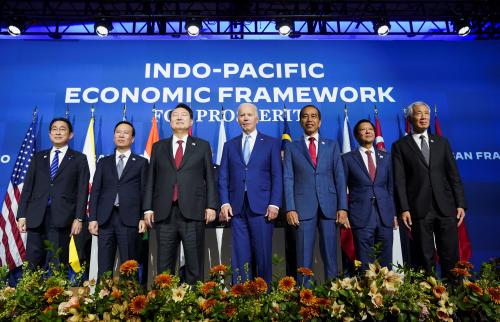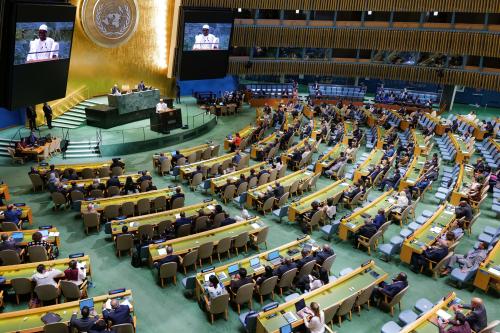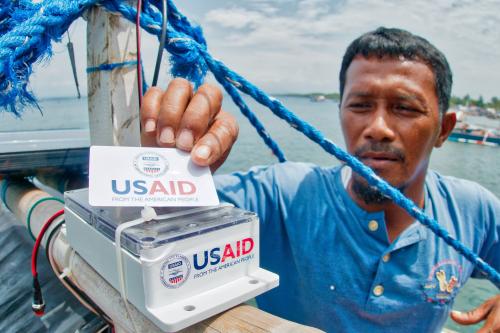This viewpoint is part of Foresight Africa 2024.
The economic growth forecast for Africa over the next two years is no more than 4% per annum.1 For a continent whose population, one-third of whom lives on less than U.S. $2.15 a day, is itself growing at more than 2.5% per annum, that is not such good news.23 It means less revenues for governments and even less money in the pockets of everyday citizens whose incomes have been eroded by inflation. Africa faces multiple challenges as it looks to 2024. Here are three lessons it can take from East Asia as it braces for the headwinds ahead.
First, reduce reliance on external sources of finance and mobilize domestic capital. A stronger U.S. dollar and high interest rates makes servicing debt much more difficult. It would be unwise to keep borrowing from international creditors: Africa needs to tap on its own pool of wealth. Start with the U.S. $2.3 trillion worth of investment funds, pension funds, and sovereign wealth funds that are locked overseas. These could be ploughed back home if the capital market was deeper. South Korea financed its own industrialization by channeling much of its domestic retirement savings into national champions such as Samsung and Hyundai. It could do that because there was a wellregulated functional capital market to facilitate such transactions. One of the key factors why industrialization in Africa has remained stagnant is the underdeveloped state of its capital markets. It is perhaps the best available means to channel domestic private savings into productive sectors of the economy. Capital market is a catalyst for capital formation. It makes it possible to pool small savings into bigger investments. The wider the participation of citizens in the capital markets, the lesser is the need for the state to rely on foreign borrowings for development. The ability to borrow through financial markets is viewed by investors as a sign of competitiveness. The success of the African Exchanges Linkage Project—a pan-African experiment aimed at unifying seven regional stock markets—could, therefore, be transformative. A well-regulated deep financial market is like a well-lubricated combustion engine. It may not be perfect, but once it fires up it can get capital from where it is available to where it is required without much friction. If the Pan-African Payment and Settlement System, which enables near-instant cross-border payments in local currency is a success it will not only remove an important impediment to intra-African trade but could also end African trade dependency on hard currencies like the U.S. dollar and third-party banks in the U.S. or Europe.
A well-regulated deep financial market is like a well-lubricated combustion engine. It may not be perfect, but once it fires up it can get capital from where it is available to where it is required without much friction.
Second, build public grain reserves and incentivize farmers to produce more staple indigenous crops by subsidizing seeds and fertilizers, delivering extension services, and guaranteeing minimum price support for their output. Food security can neither be left to the whims of the market nor the dictates of the state. Look at China: Having suffered the worst man-made famine in living memory, Beijing is so paranoid about food security that it now keeps enough rice and wheat in reserves to feed its 1.4 billion citizens for more than 18 months.4 China’s grain import dependence is no more than 19% of its requirement, while those of meat and dairy products are at 9% and 30% respectively.5 IMF estimates suggest 158 million Africans are acutely food insecure. That is nearly 13% of its population.6 African governments, on average spend less than 5% of their annual national budget on agriculture.7 In 2003, the African Union called for African governments to at least double their public expenditure and allocate at least 10% of their annual budget to the agriculture sector. Africa will also need to build strategic grain reserves if it is to counter harvest failures that will inevitably occur more frequently as the climate changes.
Third, industrialize at warp speed. Manufacturing is a time-tested path to economic transformation. When East Asia first plugged itself into the global manufacturing value chain, it did so at the bottom of the ladder, producing cheap toys, footwear, and garments. But as incomes grew, so did wages and those very same manufacturing jobs moved to South and South-East Asia where labor costs were far more competitive. Although manufacturing labor costs in Africa are still higher than those in South Asia, the gap appears to be closing.8 With a few exceptions, African economies are dominated by low-productivity services sectors. According to the World Bank, the services sector constitutes almost 47% of economic activity in sub-Saharan Africa by value. But these are typically low-productivity services that have done little to improve per capita incomes. No other sector can convert unskilled informal labor into a productive formal labor faster than manufacturing. 60% of African imports consist of manufactured goods by value.9 If some of these goods are manufactured locally, then Africa will be able to keep a greater proportion of that value at home and create new jobs. As manufacturing ramps up, so will the demand for higher-value services. Nonetheless, Africa must position itself differently. China used wage arbitrage to industrialize at a time when labor was still a key factor cost in manufacturing. But robotics and AI may soon wipe out any wage cost advantage for industrial latecomers. As supply chains shift and global trade fragments along geopolitical lines, Africa has a short window of opportunity to industrialize.
-
Footnotes
- IMF. 2023. “World Economic Outlook: Navigating Global Differences.” https://www.imf.org/en/Publications/WEO/Issues/2023/10/10/world-economic-outlook-october-2023.
- IMF. 2023. “Africa: Special Issue, October 2023. In Pursuit of Stronger Growth and Resilience.” https://www.elibrary. imf.org/display/book/9798400254772/9798400254772.xml#:~:text=In%20the%20near%20term%2C%20there,is%20 too%20early%20to%20celebrate.
- The Economist. 2020. “Africa’s population will double by 2050.” https://www.economist.com/special-report/2020/03/26/africas-population-will-double-by-2050.
- Tang, Frank and Orange Wang. South China Morning Post (SCMP). 2022. “’China didn’t hoard grains’: stockpiling to ensure domestic food security has global implications.” https://www.scmp.com/economy/china-economy/article/3173619/china-didnt-hoard-grains-stockpiling-ensure-domestic-food.
- Ibid.
- IMF. 2023. “Africa: Special Issue, October 2023. In Pursuit of Stronger Growth and Resilience.”
- McKinsey & Company. 2010. “Africa’s path to growth: Sector by Sector.” McKinsey Quarterly. https://www.mckinsey. com/featured-insights/middle-east-and-africa/africas-path-to-growth-sector-by-sector.
- Kelhofer, Kyle. 2023. Africa Singapore Business Forum.
- Cilliers, Jakkie. 2021. ISS: African Futures. “The Future of Africa: Challenges and Opportunities.”






Commentary
Battling global headwinds: Three lessons for Africa from East Asia
August 13, 2024